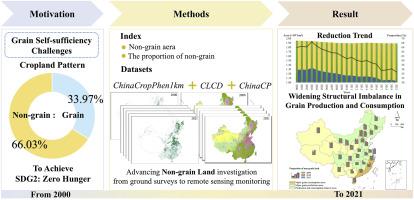Understanding the structural imbalance in non-grain land Utilization: Insights from China's arable land policy
IF 5.4
2区 地球科学
Q1 GEOGRAPHY
引用次数: 0
Abstract
For populous nations, a comprehensive assessment and effective management of cultivated land structure are essential for ensuring stable grain production and sustaining the global grain market. This research defines non-grain land as cultivated areas not used for staple grain crops (rice, wheat, and maize) and examines its conversion processes and interactions with grain land over the past two decades under the influence of policy, natural conditions, and socio-economic factors. Key findings include: (1) Non-grain land experienced a dual decline in quantity (19.71 %) and productivity (25.40 %), highlighting the limitations of current non-grain land management policies in addressing sustainability. (2) The most pronounced decrease occurred in major grain production areas, where the proportion of non-grain land fell from 0.63 % to 0.54 %, accounting for 92 % of the nationwide reduction. In production-consumption balance areas, the proportion moderately declined from 0.76 % to 0.69 %, while major consumption areas saw a slight increase from 0.63 % to 0.65 %. (3) Regional conversions in non-grain utilization of cultivated land exhibit strong policy alignment and synergy with national farmland protection and food security strategies, reflecting the trend of regional specialization in grain production. This study underscores the pressing need for data-driven, region-specific policies to optimize cultivated land use, enhance sustainable productivity, and provide strategic guidance for nations facing food supply-demand imbalances on a global scale.

解读非粮食土地利用结构失衡:来自中国耕地政策的启示
对于人口大国来说,全面评估和有效管理耕地结构是确保粮食稳定生产和维持全球粮食市场的关键。本研究将非粮食用地定义为不用于种植主粮作物(水稻、小麦和玉米)的耕地,并考察了过去二十年来在政策、自然条件和社会经济因素的影响下,其转化过程以及与粮食用地的相互作用。主要发现包括:(1)非粮食土地在数量(19.71%)和生产力(25.40%)上出现了双重下降,突出了当前非粮食土地管理政策在解决可持续性问题方面的局限性。(2)粮食主产区减少幅度最大,非粮食用地占比从0.63%下降到0.54%,占全国减少面积的92%。在产销平衡地区,这一比例从0.76%适度下降到0.69%,而在主要消费地区,这一比例从0.63%略微上升到0.65%。③耕地非粮食利用区域转换与国家耕地保护和粮食安全战略具有较强的政策契合和协同效应,反映了粮食生产区域专业化的趋势。本研究强调,迫切需要数据驱动的区域政策,以优化耕地利用,提高可持续生产力,并为全球范围内面临粮食供需失衡的国家提供战略指导。
本文章由计算机程序翻译,如有差异,请以英文原文为准。
求助全文
约1分钟内获得全文
求助全文
来源期刊

Applied Geography
GEOGRAPHY-
CiteScore
8.00
自引率
2.00%
发文量
134
期刊介绍:
Applied Geography is a journal devoted to the publication of research which utilizes geographic approaches (human, physical, nature-society and GIScience) to resolve human problems that have a spatial dimension. These problems may be related to the assessment, management and allocation of the world physical and/or human resources. The underlying rationale of the journal is that only through a clear understanding of the relevant societal, physical, and coupled natural-humans systems can we resolve such problems. Papers are invited on any theme involving the application of geographical theory and methodology in the resolution of human problems.
 求助内容:
求助内容: 应助结果提醒方式:
应助结果提醒方式:


